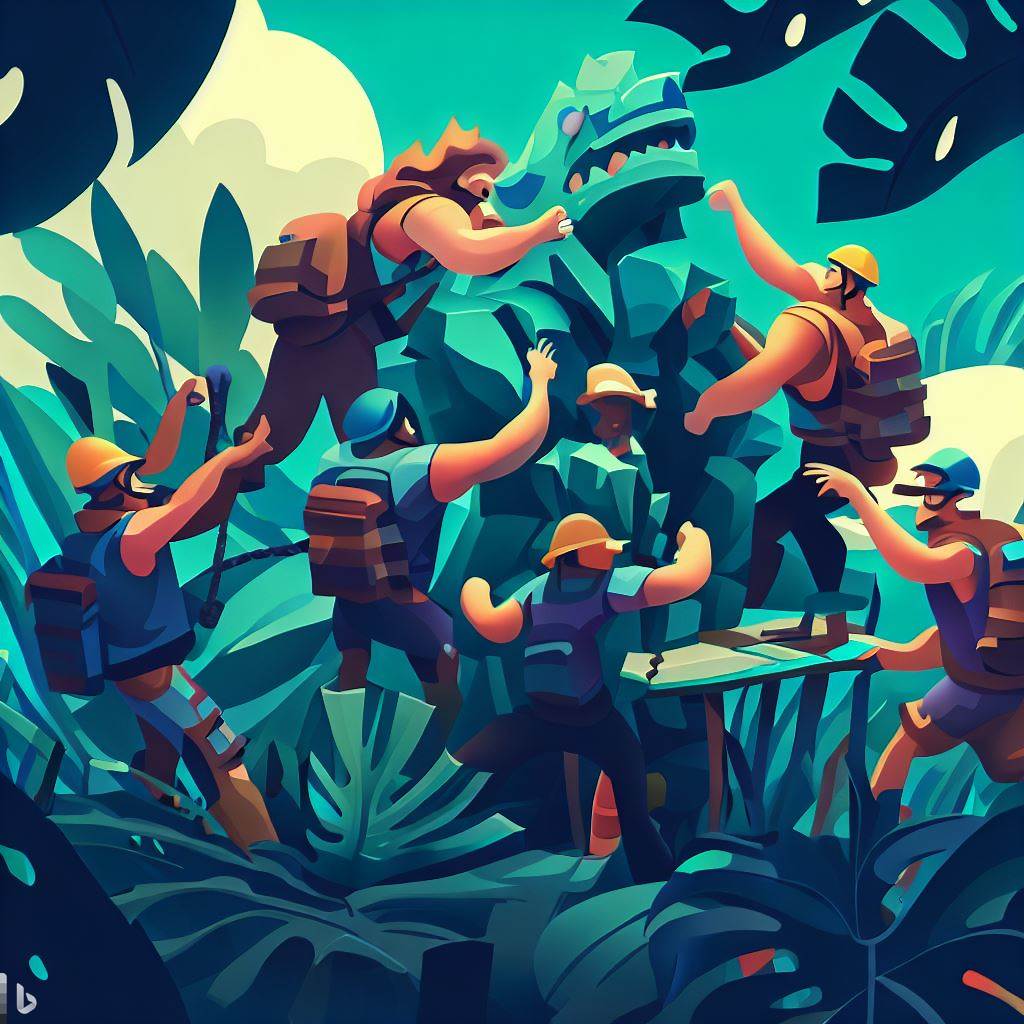
Terraform Git Repositories vol. 1: Unleashing Collaborative Magic in the Cloud
Introduction
In the frenzied realm of Terraform and the wild wonders of collaborative cloud development, I embark on a daring expedition.
Inspired by Bibin Wilson, whose mystical LinkedIn post unveiled the enigmatic British Ministry of Justice’s Terraform repository, I dive headfirst into the captivating chaos of the Modernisation Platform. This GitHub odyssey, located at GitHub – Ministry of Justice Modernisation Platform, is a battleground where fearless developers and audacious Ops warriors come together, mastering the intricacies of infrastructure. Join us as we unveil the best practices for managing Terraform repositories, ensuring seamless collaboration, and embarking on extraordinary cloud adventures.
In this daring expedition, we’ll dive into the untamed jungles of collaborative development, where daring developers and fearless ops warriors unite to tame the chaos and forge magnificent infrastructure landscapes.
Blazing trails with collaborative workflows
Welcome to the wild world of Terraform Git repositories, where collaboration meets the cloud in a symphony of infrastructure orchestration. In the wild and unpredictable realm of Terraform, a hidden treasure awaits. Deep within the intricate GitHub repository of the British Ministry of Justice’s Modernisation Platform lie the keys to unlocking the true potential of collaborative magic to navigate the exhilarating world of Terraform.

Behind the golden gates of the Terraform jungle lies the “policies/collaborators” directory, a mystical realm where structure meets strategy. This is the beating heart of your collaborative ecosystem, the blueprint that dictates how your teams work together to bring your infrastructure dreams to life.
But why enter this magical world? Because this directory is more than just a part of the repository. It’s the cornerstone where strategic decisions take shape, embodying the very essence of access control and delegation in the Terraform universe. By venturing into this directory and defining roles and permissions, you’re crafting a harmonious environment where collaboration flourishes. As you assign tasks and delegate responsibilities, you are not merely managing – you are sculpting a culture of teamwork that propels your Terraform projects to extraordinary heights.
Dive into the GitHub/modules/contributor directory
However, the magic doesn’t end with the “policies/collaborators” directory. Venture deeper into the GitHub/modules/contributor directory. Here, you’ll find tools and configurations tailored to streamline the contributions of each team member. The structures and standards defined within can be likened to the shared rhythms that ensure each member of an orchestra plays in harmony.
Think of it this way: Your contributors are like musicians in an orchestra, each one skilled and creative. But without a conductor to guide them and a common sheet of music to play from, the performance can quickly descend into chaos.
Imagine your Terraform project as an epic saga set in a vast fantasy world. Each contributor is a unique hero or heroine, a bearer of distinct skills and strategies akin to a dwarf blacksmith or an elven archer. The standardized functionality and permissions in the “GitHub/modules/contributor” directory act as your ancient scrolls of the law, the governing principles that shape the code kingdom.
Just as every character in an epic fantasy story has their role to play, these laws help define the part each contributor plays in your project’s grand tale. They ensure consistency in how deeds (tasks) are performed and contributions (victories) are made, helping to ward off the twin dragons of miscommunication and error.
Like a kingdom guided by wise rulers and ancient laws, this structure allows your heroes – the contributors – to focus on their unique roles. They’re free to wield their individual talents, all while your grand saga – your Terraform project – advances coherently toward its monumental conclusion.
Embrace pull request expeditions
As you embark on this thrilling adventure, brace yourself for the heart-pounding world of pull request expeditions. Pull requests are key features of GitHub’s collaborative model, serving as a platform for peer review and are vital for maintaining the integrity of the codebase. Each pull request represents a proposed change to the code, and through a systematic review process, team members can assess, discuss, and refine these changes. It’s through this meticulous process you get to fine-tune, refine, and elevate the quality of your Terraform codebase.
Pull requests help prevent bugs and other issues from being merged into your main codebase, and they encourage knowledge-sharing and collaborative problem-solving. By embracing this tool and engaging in code reviews, you create a culture where the spirit of collaboration reigns supreme. This isn’t just a journey through the unknown but a practical, ongoing exercise in team learning and code refinement.
Navigating each pull request becomes a triumph of teamwork and a step closer to a robust and resilient infrastructure. By fostering a constructive and thorough review process, you’re not just developing code, you’re cultivating a collective understanding and appreciation for quality and stability in your Terraform projects.
Establish clear guidelines to guide your fearless explorers
Amidst the treacherous paths of change, lay down clear and comprehensive contribution guidelines. Think of these guidelines as your trusty compass, guiding every fearless explorer through the Terraform development landscape. They should encompass everything from code standards to documentation conventions, creating a roadmap that ensures everyone can contribute effectively and harmoniously.
So, grab your keyboard, rally your team, and embark on this practical expedition into the realm of Terraform. Together, you’ll conquer the cloud, build extraordinary infrastructure, and leave your mark on the ever-evolving world of collaborative Terraform development. Let the adventure begin!
Prepare for the Battle of Security
In the mystical realm of Terraform, where secrets hold great power and access control beasts lurk in the shadows, it’s time to channel your inner gatekeeper. You’ve navigated the realm of collaboration in the “policies/collaborators” directory, but now, it’s time to face its other role – security. Here, you’ll sculpt majestic roles and access controls, establishing a hierarchy that reigns supreme over your collaborative domain. Assign permissions with precision, granting your trusted allies the right level of authority to protect and shape your infrastructure.

Protecting secrets and taming access control beasts
But vigilance alone is not enough. Fortify your defenses by regularly reviewing and adjusting access controls. Keep a watchful eye on potential threats that may try to infiltrate your realm. Stay one step ahead, adapting your defenses to ensure that only the chosen few hold the keys to your kingdom.
Embolden your guardians with multi-factor authentication
To embolden your guardians, enable the mighty power of multi-factor authentication (MFA). By requiring additional layers of verification, such as codes or biometric data, you fortify your kingdom’s gates, making it impenetrable to all but the most resolute intruders. Let the strength of MFA be the shield that protects your realm from unwanted access.
In this eternal battle for security, your Terraform kingdom will stand strong, its secrets guarded, and its access control beasts tamed. Embrace these valiant practices, and become the guardian of your digital domain.
Automating the cloud symphony
Now, let’s ascend to the cloud tops, where automation reigns supreme, unlocking the true power of Terraform. It’s not merely a technical tool—it’s an ethereal realm where each line of code invokes potent spells of efficiency. As we venture further on our quest, these advanced practices will empower your team, helping you conquer the formidable heights of the cloud.
Unleash the hidden scripts directories
Unleash the hidden scripts and tools concealed within the “scripts/internal” and “scripts/tests” directories. With a stroke of technical brilliance, automate the intricate dance of pull requests, code reviews, and deployments. Harness the capabilities of automation frameworks to streamline your development workflows and achieve unparalleled efficiency.
Cast reliability spells upon your Terraform code
Enchant your infrastructure creations with the magic of automated testing to cast spells of reliability and resilience upon your Terraform code. Craft comprehensive test suites and leverage testing frameworks to perform rigorous validation of your infrastructure changes. With each test run, gain confidence in the stability and robustness of your deployments.

Unleash the mighty forces of continuous integration and deployment (CI/CD) pipelines
Unleash the mighty forces of your continuous integration and deployment (CI/CD) pipelines. Forge an automated symphony of cloud orchestration, seamlessly integrating your Terraform infrastructure changes with your chosen deployment platform. Leverage version control systems, build automation tools, and deployment pipelines to orchestrate the deployment of your infrastructure changes with precision and agility.
Within this realm of technical mastery, automation becomes the driving force that propels your Terraform workflows to new heights. Embrace these advanced practices, and witness the seamless integration, reliability, and scalability that automation brings to your cloud infrastructure deployments. Let your technical prowess harmonize with the power of automation, unleashing a symphony of efficiency and effectiveness in the cloud.
Chronicles of wisdom: Sharing the journey
Now, let’s shift our gaze from the tangible to the wisdom captured in words. In the ‘docs’ directory, you craft the saga of your Terraform exploits, crafting tales of guidelines, standards, and best practices. Your words, far from mere documentation, become guideposts for future explorers in the ever-evolving Terraform wilderness.
The journey continues deeper with the ‘source/concepts’ directory, where the essence of Terraform’s infrastructure principles is revealed. This exploration unravels the complexities of resource provisioning, module composition, and state management. With this wisdom, we don’t just navigate the repository more effectively; we shape the very fabric of our collaborative Terraform adventure.

Unveil the heroes and heroines of your team within the hallowed halls of the “source/team” directory. Paint a vivid portrait of roles and responsibilities, capturing the spirit and dedication of your team members. Celebrate their contributions and achievements, fostering a sense of unity and empowerment. Let newcomers be inspired by the stories of those who have walked the Terraform path before them, igniting their own passions and talents.
In these mystical directories, the true essence of Terraform isn’t just coded; it’s narrated and shared. As you document your insights and unlock the secrets of infrastructure principles, you do more than just create files. You spark conversations, foster learning, and encourage collaboration.
Why is this important? Because in the complex world of cloud infrastructure, shared understanding and collective wisdom are invaluable. By documenting your experiences and discoveries, you provide a roadmap for your team – and potentially, the wider Terraform community – to navigate the challenges of infrastructure orchestration.
How does this happen? Through the act of writing your team’s story, you not only record your unique journey but also craft a narrative that reflects your team’s values, successes, and lessons learned. This creates a sense of unity and shared purpose, and it allows everyone to understand and contribute to your collective vision.
With each story, each piece of shared wisdom, you build a stronger community, united by a shared vision and fueled by the power of Terraform’s transformative magic. This is the true power of these directories: They help you forge a path toward greatness, not just through the code you write but through the stories you tell and the knowledge you share.
Note: The GitHub repository for the MoJ Modernisation Platform, where these directories can be found, can be accessed at GitHub Repository.
Conclusion
In the ever-evolving Terraform universe, collaborative Git repositories become portals to boundless possibilities. By embracing these untamed best practices, fearless teams can conquer the clouds, build majestic infrastructure landscapes, and bask in the glory of seamless collaboration. So, grab your gear, sharpen your wits, and embark on a thrilling journey where Terraform Git repositories unlock the secrets of the cloud, and adventurers become legendary cloud architects.

Here are the rules:
1. Define Roles Clearly: Clear definition of roles and permissions within your team enhances collaborative efforts and minimizes confusion.
2. Standardize Practices: Establish and maintain standardized practices across all development efforts to ensure consistency and improve collaboration.
3. Embrace Code Reviews: Use code review practices, like pull requests, to maintain code integrity, encourage knowledge sharing, and promote collaborative problem-solving.
4. Develop Comprehensive Guidelines: Draft clear and comprehensive guidelines for every aspect of the project to facilitate effective contribution from all team members.
5. Prioritize Security: Implement strict security measures, including access controls and multi-factor authentication, to protect your project from potential threats.
6. Automate Wherever Possible: Automation of workflows and processes enhances efficiency, reliability, and scalability of projects.
7. Share Knowledge and Learn: Promote a culture of learning and knowledge sharing within the team. This helps in individual growth as well as improves the collective understanding of the project.
8. Remain Open to Exploration: Be willing to explore new landscapes within your project repository. This openness can lead to innovative solutions and insights.
9. Embrace Challenges: Treat every project as an exciting adventure, driving you to push boundaries and deliver high-quality results.
Note: Images used in this article are for illustrative purposes only and may not reflect the exact content of the mentioned directories.